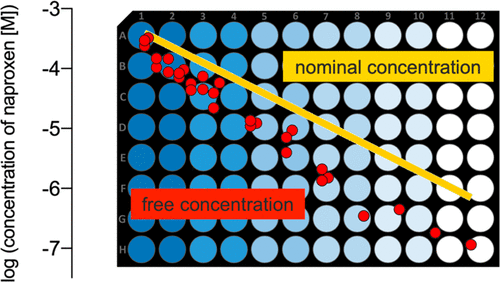当前位置:
X-MOL 学术
›
Chem. Res. Toxicol.
›
论文详情
Our official English website, www.x-mol.net, welcomes your
feedback! (Note: you will need to create a separate account there.)
Experimental Exposure Assessment of Ionizable Organic Chemicals in In Vitro Cell-Based Bioassays.
Chemical Research in Toxicology ( IF 3.7 ) Pub Date : 2020-05-05 , DOI: 10.1021/acs.chemrestox.0c00067 Julia Huchthausen 1 , Marie Mühlenbrink 1 , Maria König 1 , Beate I Escher 1, 2 , Luise Henneberger 1
Chemical Research in Toxicology ( IF 3.7 ) Pub Date : 2020-05-05 , DOI: 10.1021/acs.chemrestox.0c00067 Julia Huchthausen 1 , Marie Mühlenbrink 1 , Maria König 1 , Beate I Escher 1, 2 , Luise Henneberger 1
Affiliation

|
Exposure assessment in in vitro cell-based bioassays is challenging for ionizable organic chemicals (IOCs), because they are present as more than one chemical species in the bioassay medium. Furthermore, compared to neutral organic chemicals, their binding to medium proteins and lipids is driven by more complex molecular interactions. Total medium concentrations (Ctotal,medium) and/or freely dissolved medium concentrations (Cfree,medium) were determined for one neutral chemical and 14 IOCs (acids, bases, multifunctional) at concentrations relevant for determination of cytotoxicity and effect. Cfree,medium was measured in two in vitro bioassays at the time of dosing and after 24 h of incubation using solid-phase microextraction. Cfree,medium was maximally 1.7 times lower than the nominal concentrations (Cnom) for the hydrophilic chemicals (caffeine and lamotrigine). For the organic acids (naproxen, ibuprofen, warfarin, and diclofenac), Cfree,medium was by a factor of 4 lower than Cnom at high concentrations, but the ratio was much higher at low concentrations, indicating a nonlinear binding behavior. The experimental Cfree,medium was also compared with Cfree,medium predicted with a mass balance model accounting for binding to medium proteins and lipids. The mass balance model performed well for five of the test chemicals (within a factor of 10), but it underestimated Cfree,medium by up to a factor of 1200 for chemicals that showed nonlinear binding to medium components. These findings emphasize that experimental exposure assessment is required for improved understanding of in vitro toxicity data.
中文翻译:

在基于细胞的体外生物测定中对可电离有机化学物质的实验暴露评估。
对于可电离的有机化学物质(IOC),基于细胞的体外生物测定中的暴露评估具有挑战性,因为它们在生物测定介质中以一种以上的化学物质形式存在。此外,与中性有机化学物质相比,它们与中等蛋白质和脂质的结合是由更复杂的分子相互作用驱动的。对于一种中性化学物质和14种IOC(酸,碱,多功能),以与确定细胞毒性和作用有关的浓度确定总培养基浓度(C总,中等)和/或自由溶解的培养基浓度(C游离,中等)。两次体外测定无C培养基给药时和使用固相微萃取孵育24小时后进行生物测定。Ç免费,介质是比标称浓度(降低最大1.7倍Ç NOM)为亲水性的化学品(咖啡因和拉莫三嗪)。对于有机酸(萘普生,布洛芬,华法林,和双氯芬酸),Ç免费,介质是由低于4倍Ç NOM浓度高,但该比例为低浓度高得多,表明非线性结合行为。实验Ç免费,介质也与比较Ç免费,介质用质量平衡模型进行预测,该模型考虑了与中等蛋白质和脂质的结合。质量平衡模型对于五种测试化学品(在10倍以内)的性能很好,但是对于显示出与中等组分的非线性结合的化学品,它低估了C的游离C值高达1200倍。这些发现强调,需要进行实验性暴露评估才能更好地了解体外毒性数据。
更新日期:2020-05-05
中文翻译:

在基于细胞的体外生物测定中对可电离有机化学物质的实验暴露评估。
对于可电离的有机化学物质(IOC),基于细胞的体外生物测定中的暴露评估具有挑战性,因为它们在生物测定介质中以一种以上的化学物质形式存在。此外,与中性有机化学物质相比,它们与中等蛋白质和脂质的结合是由更复杂的分子相互作用驱动的。对于一种中性化学物质和14种IOC(酸,碱,多功能),以与确定细胞毒性和作用有关的浓度确定总培养基浓度(C总,中等)和/或自由溶解的培养基浓度(C游离,中等)。两次体外测定无C培养基给药时和使用固相微萃取孵育24小时后进行生物测定。Ç免费,介质是比标称浓度(降低最大1.7倍Ç NOM)为亲水性的化学品(咖啡因和拉莫三嗪)。对于有机酸(萘普生,布洛芬,华法林,和双氯芬酸),Ç免费,介质是由低于4倍Ç NOM浓度高,但该比例为低浓度高得多,表明非线性结合行为。实验Ç免费,介质也与比较Ç免费,介质用质量平衡模型进行预测,该模型考虑了与中等蛋白质和脂质的结合。质量平衡模型对于五种测试化学品(在10倍以内)的性能很好,但是对于显示出与中等组分的非线性结合的化学品,它低估了C的游离C值高达1200倍。这些发现强调,需要进行实验性暴露评估才能更好地了解体外毒性数据。









































 京公网安备 11010802027423号
京公网安备 11010802027423号